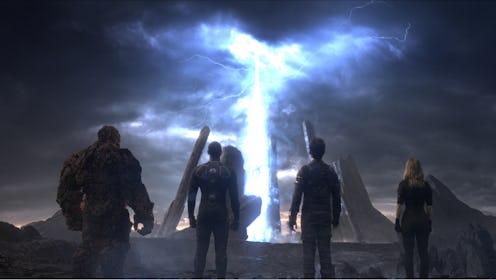Entertainment
How 'Fantastic Four' Differs From The Comics

For many superhero fans, the exciting news that there would be a Fantastic Four reboot came with the worry that Josh Trank, director and co-writer of the movie, would be taking Marvel's first family in a different direction. In some ways, they were right; unlike the first two installments, which garnered mixed reactions from fans, Trank's version had a realistic and gritty tone. More importantly, the story changed, too, making this version of Fantastic Four different from the comics.
Yet even though Trank had an ambitious new take on the team, the members still remain the same: the elastic Mr. Fantastic (Miles Teller), the force field-wielding Invisible Woman (Kate Mara), the snarky hot-headed Human Torch (Michael B. Jordan) and the gruff Thing (Jamie Bell). And of course, they have their nemesis: the evil Dr. Doom (Tony Kebbell). The required fixtures of the story are there. Still, it's the actual details of the story that has a lot of people, including myself, raising eyebrows. Instead of using the original storyline for the team of heroes, Trank opted to follow the Ultimate Fantastic Four comic book series — a slightly different story from the first 1961 issue of the Fantastic Four.
The Ultimate version was an alternate, more modern version of the FF, which made the team younger and therefore easier to market to young, hipper audiences. In it, Reed (Mr. Fantastic) is a child prodigy who leaves his small town and his childhood friend Ben (The future Thing) goes and studies at the Baxter Building in New York at the request of Dr. Franklin Storm. Long story short: he becomes chummy with Sue Storm (the Invisible Woman), meets her brother Johnny (the Human Torch) and develops a rivalry with fellow student Victor Van Damme (Von Doom in the movie and other books) while building a machine that travels to another dimension. This story is the foundation for Trank's movie.
Ultimate version aside, Fantastic Four purists of the original version will notice some other major differences between Trank's movie and the comics. Here are the ones that you should look out for:
The Alternate Dimension Vs. Outer Space
In the 1961 comic book, Reed, Sue, Johnny and Ben go on an special expedition to space and are exposed to cosmic rays that give them their special powers. There is no alternate dimension — just good ol' fashioned outer space action.
The Origin Of Dr. Doom
Victor Von Doom never was really part of the team that went to space (or an alternate dimension for that matter). In fact, he didn't have a full origin story until Fantastic Four Annual #2, which was two years after his debut. His story involves his life in the fictional country of Latveria and is neck deep in science, sorcery and his gypsy family. It's a big difference from the emo techie in the movie.
The Storm Family
The fact that they cast Michael B. Jordan as the Human Torch (who is typically portrayed as white in the comics) or that Sue was adopted isn't and should never be an issue. The main difference is the dynamic of the Storm family. Their father, Franklin Storm, probably saw the most change from the comics. In the comics, he is a surgeon who blames himself for not being able to save his wife after an accident. He falls into alcoholism and gambling debt which eventually leads to prison. Maybe it's good they made him more of a successful scientist in this one.
Reed And Sue's Relationship
Considering the Fantastic Four movie is sort of a "prequel," it's understandable that Marvel's favorite couple haven't tied the knot yet, like they do in the comics. Still, signs of their budding romance are present throughout the movie.
The movie and the comics are separate entities, so the differences are understandable. Perhaps the sequel will bring the storylines closer together.
Images: Twentieth Century Fox (2), Giphy (3)